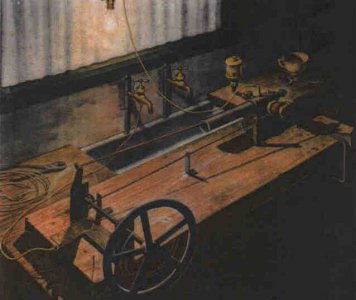It is nick-named the "kitchen sink engine" by some, because over Christmas 1893, all exited, Henry brought his first engine home to show Mrs Ford, clamped it to the kitchen sink and with her help started it up.
I intend to build a replica with my grandson to show him that you can build an engine from bits lying about and get him to use some of my tools and machines.
In our scociety I don't believe his generation will ever be let anywhere near machine tools unless they get a job in a machine shop. Sadly, if you don't have a sense of what a machine shop looks like or what can be done there and how exciting it is to see raw materials transformed into complicated and valuable goods, why would you ever want to consider a career in machining or tool-making or metal production/fabrication?
Anyway, after that ramble, I actually wandered if anyone has ever seen the engine in the Ford museum in Dearborn, Michigan - or can incorporate a look for this engine in their next visit there?
I know I can buy replica plans (does anyone here have a set for sale, by the way - even scanned as a PDF is fine?), but I have never seen any photos of the original. I have a small sketch of it (from a magazine of the day I believe), but is shows little technical detail, because the artist who drew it probably didn't knwo what he or she was looking at, so it's an impression rather than a representation.
I would really like to see a couple of photos of the actual original engine Henry built.
If anyone can help, I'd be very grateful - and my grandson will be too in time.... when he realises the significane of this project in a few years' time.
Cheers,
Joe in Australia

I intend to build a replica with my grandson to show him that you can build an engine from bits lying about and get him to use some of my tools and machines.
In our scociety I don't believe his generation will ever be let anywhere near machine tools unless they get a job in a machine shop. Sadly, if you don't have a sense of what a machine shop looks like or what can be done there and how exciting it is to see raw materials transformed into complicated and valuable goods, why would you ever want to consider a career in machining or tool-making or metal production/fabrication?
Anyway, after that ramble, I actually wandered if anyone has ever seen the engine in the Ford museum in Dearborn, Michigan - or can incorporate a look for this engine in their next visit there?
I know I can buy replica plans (does anyone here have a set for sale, by the way - even scanned as a PDF is fine?), but I have never seen any photos of the original. I have a small sketch of it (from a magazine of the day I believe), but is shows little technical detail, because the artist who drew it probably didn't knwo what he or she was looking at, so it's an impression rather than a representation.
I would really like to see a couple of photos of the actual original engine Henry built.
If anyone can help, I'd be very grateful - and my grandson will be too in time.... when he realises the significane of this project in a few years' time.
Cheers,
Joe in Australia

Last edited by a moderator:

